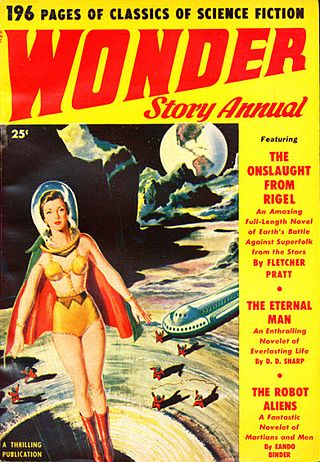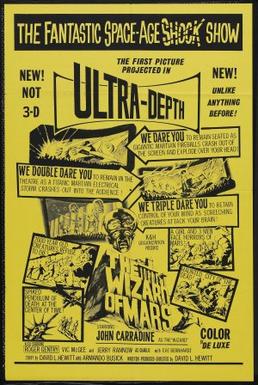
Mars, the fourth planet from the Sun, has appeared as a setting in works of fiction since at least the mid-1600s. Trends in the planet's portrayal have largely been influenced by advances in planetary science. It became the most popular celestial object in fiction in the late 1800s, when it became clear that there was no life on the Moon. The predominant genre depicting Mars at the time was utopian fiction. Around the same time, the mistaken belief that there are canals on Mars emerged and made its way into fiction, popularized by Percival Lowell's speculations of an ancient civilization having constructed them. The War of the Worlds, H. G. Wells's novel about an alien invasion of Earth by sinister Martians, was published in 1897 and went on to have a major influence on the science fiction genre.

A space suit or spacesuit is a garment worn to keep a human alive in the harsh environment of outer space, vacuum and temperature extremes. Space suits are often worn inside spacecraft as a safety precaution in case of loss of cabin pressure, and are necessary for extravehicular activity (EVA), work done outside spacecraft. Space suits have been worn for such work in Earth orbit, on the surface of the Moon, and en route back to Earth from the Moon. Modern space suits augment the basic pressure garment with a complex system of equipment and environmental systems designed to keep the wearer comfortable, and to minimize the effort required to bend the limbs, resisting a soft pressure garment's natural tendency to stiffen against the vacuum. A self-contained oxygen supply and environmental control system is frequently employed to allow complete freedom of movement, independent of the spacecraft.

Voskhod 2 was a Soviet crewed space mission in March 1965. The Vostok-based Voskhod 3KD spacecraft with two crew members on board, Pavel Belyayev and Alexei Leonov, was equipped with an inflatable airlock. It established another milestone in space exploration when Alexei Leonov became the first person to leave the spacecraft in a specialised spacesuit to conduct a 12-minute spacewalk.

A space capsule is a spacecraft designed to transport cargo, scientific experiments, and/or astronauts to and from space. Capsules are distinguished from other spacecraft by the ability to survive reentry and return a payload to the Earth's surface from orbit or sub-orbit, and are distinguished from other types of recoverable spacecraft by their blunt shape, not having wings and often containing little fuel other than what is necessary for a safe return. Capsule-based crewed spacecraft such as Soyuz or Orion are often supported by a service or adapter module, and sometimes augmented with an extra module for extended space operations. Capsules make up the majority of crewed spacecraft designs, although one crewed spaceplane, the Space Shuttle, has flown in orbit.

Men Into Space is an American black-and-white science fiction television series, produced by Ziv Television Programs, Inc., that was first broadcast by CBS from September 30, 1959, to September 7, 1960. The series depicts future efforts by the United States Air Force to explore and develop outer space. The series' star, William Lundigan, played Col. Edward McCauley.

Mission to Mars is a 2000 American science fiction adventure film directed by Brian De Palma, written by Jim Thomas, John Thomas, and Graham Yost, and suggested by Disney's theme park attraction of the same name. The film depicts the first crewed Mars exploration mission going awry; American astronaut Jim McConnell helps to coordinate a rescue mission for a colleague. Principal support actors were Tim Robbins, Don Cheadle, Connie Nielsen, Jerry O'Connell, and Kim Delaney.

Robinson Crusoe on Mars is a 1964 American science fiction film directed by Byron Haskin and produced by Aubrey Schenck that stars Paul Mantee, Victor Lundin, and Adam West. It is a science fiction retelling of the classic 1719 novel Robinson Crusoe by Daniel Defoe. The film was distributed by Paramount Pictures and filmed in Technicolor and Techniscope.

Dragon is a family of spacecraft developed and produced by American private space transportation company SpaceX. The first family member, later named Dragon 1, flew 23 cargo missions to the ISS between 2010 and 2020 before retiring. This version, not designed to carry astronauts, was funded by NASA with $396 million awarded through the Commercial Orbital Transportation Services (COTS) program, with SpaceX announced as a winner of the first round of funding on August 18, 2006.

Science fiction authors have designed imaginary spacesuits for their characters almost since the beginning of fiction set in space.

The Wizard of Mars is a 1965 American science fiction film directed and co-written by David L. Hewitt, based on L. Frank Baum's 1900 novel The Wonderful Wizard of Oz. The title character is portrayed by John Carradine, who gives a lengthy monologue as a projection near the end of the film.

Invaders from Mars is a 1986 American science fiction horror film, directed by Tobe Hooper from a screenplay by Dan O'Bannon and Don Jakoby. It is a remake of the 1953 film of the same name, and is a reworking of that film's screenplay by Richard Blake from an original story by John Tucker Battle. Its production was instigated by Wade Williams, millionaire exhibitor, science fiction film fan and sometime writer-producer-director, who had reissued the original film in 1978 after purchasing the copyright to the property. Elaborate creature and visual effects were supplied by Stan Winston and John Dykstra.

Stranded is a 2001 English-language Spanish science fiction film about a fictional first crewed mission to Mars. It stars Vincent Gallo and Maria de Medeiros, and was directed by Spanish filmmaker and actress María Lidón, with screenplay by Spanish science fiction author Juan Miguel Aguilera. Lidón won the "Grand Prize of European Fantasy Film in Silver", and Gallo and de Medeiros were named best actors at the 2002 Fantafestival in Rome.

Nebo Zovyot is a 1959 Soviet science fiction adventure film directed by Aleksandr Kozyr and Mikhail Karyukov. It was filmed at Dovzhenko Film Studios in 1959 and premiered September 12, 1959.

The Throne of Saturn is a 1971 science fiction/political novel by Allen Drury that explores the preparations for a near-future crewed mission to the planet Mars.

Destination Space is a 1959 American science fiction television film. It was produced and written by Rip Van Ronkel and directed by Joseph Pevney.

A Mars suit or Mars space suit is a space suit for EVAs on the planet Mars. Compared to a suit designed for space-walking in the near vacuum of low Earth orbit, Mars suits have a greater focus on actual walking and a need for abrasion resistance. Mars' surface gravity is 37.8% of Earth's, approximately 2.3 times that of the Moon, so weight is a significant concern, but there are fewer thermal demands compared to open space. At the surface the suits would contend with the atmosphere of Mars, which has a pressure of about 0.6 to 1 kilopascal. On the surface, radiation exposure is a concern, especially solar flare events, which can dramatically increase the amount of radiation over a short time.
















